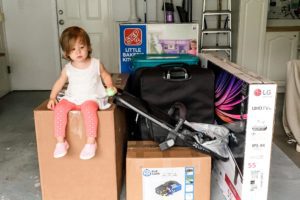This is based on the experience of our family. Details may be different for each family in the game of baseball depending on organization or location.
Baseball looks a little different this season. For fans. For players. And for our family. After 12 years in the game, our family is starting a new chapter. So as the “season” kicks off, almost three months late, it feels only right to reflect on our time in the game. I thought it would be fun to share a glimpse into a (typical) year in the life of a baseball family.

Although baseball season doesn’t “start” until April, for a player and his family, it starts long before that. Typically, February 1st, to be exact. The middle of February marks the beginning of Spring Training. And where is Spring Training? Either Florida or Arizona. All 30 teams “train” for the season in one of two states. So for the family of a pitcher living in the snow (or ice) covered midwest, that means you arrive at Spring Training no later than the first of February. This allows you to get acclimated to the weather, the facility, or possibly a new group of teammates.
Let the packing begin. In January, when the guys begin intense workouts, the wives begin intense packing. When you leave for Spring Training, you don’t return home until the end of the season . . . September or October (if you’re lucky). The packing is the trickiest part and quite possibly takes the entire month of January. You pack dishes, pots, pans, sheets, towels, toys for your kids, and then clothes. Lots of clothes. Clothes for eight months, different climates, and seasons. And it’s all predictable until you get traded. Let’s just say we own kids’ clothes in all sizes for all seasons.
 So how does a family get eight months’ worth of “stuff” halfway across the country? Well, you have two options. You drive it, or you ship it! In the early years of the minor leagues, when funds were tight, we would drive. Sometimes it was two cars, and other times one truck towing a car both of which were loaded with stuff. Later in our baseball journey, we would ship two cars, packed as full as we could get them. Depending on the shipping company, you can often pack the car to the windows . . . which is a lot less stuff than you think. And you travel with the rest. Paying baggage fees quickly becomes your specialty.
So how does a family get eight months’ worth of “stuff” halfway across the country? Well, you have two options. You drive it, or you ship it! In the early years of the minor leagues, when funds were tight, we would drive. Sometimes it was two cars, and other times one truck towing a car both of which were loaded with stuff. Later in our baseball journey, we would ship two cars, packed as full as we could get them. Depending on the shipping company, you can often pack the car to the windows . . . which is a lot less stuff than you think. And you travel with the rest. Paying baggage fees quickly becomes your specialty.
Spring Training housing. How do you find a place to live for just two months? You look. Really, really hard. You scour Zillow, Air BnB, VRBO, and you make cold calls to realtors. You reach out to friends and family who may live in the area or have a second cousin twice removed who just relocated to the area. And contrary to popular belief, the team does not provide housing. Luckily, the network amongst teammates, past and present, and their wives is strong, and somehow it always works out. But it doesn’t mean you may not find yourself in an extended stay or on someone’s couch for a few nights.
As Spring Training starts to wrap up, the housing search begins again. Looking for season housing is a bit different. Because you often don’t know where you’re going until the last minute. Each major league team has five levels of the minor leagues. And most guys are jockeying between two teams for most of Spring Training. There have been many times that we got our “assignment” for the season on the very last day of Spring Training. This leaves no choice but to drive, sometimes 24 hours in three days, from Florida to the North East.
Season starts, and if you’re lucky, you’re in one town all season. Often trades, promotions, or demotions make for more moves. A mid-season move means the player leaves within hours of the assignment change, leaving behind an apartment to pack, cars to relocate, and possibly a few kids and a wife. And once the season ends, you make the long journey home for a four-month off-season before it starts all over again.
Cheers to the players, coaches, staff, and their families who are braving a global pandemic to bring us America’s favorite pastime.











